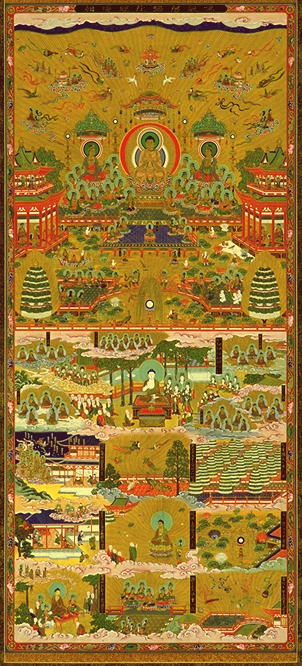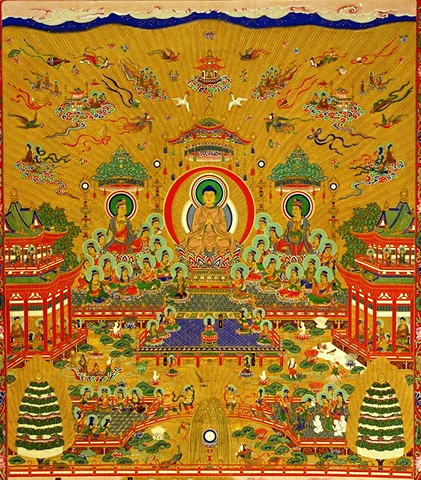THE AMIDA SUTRA MANDALA
Back to Index
[Whole picture]

Jump to: [A],[B],[C],[Upper
part - Image A],
[Upper part - Chart A], [Lower
part - Image],
[Lower part - Chart B], [Lower
part - Chart C]
Return to Index
INTRODUCTION
This is the most recent of the three mandalas,
dating from 1867. This is a hanging scroll,
measuring 128 by 58 cm., painted on silk
in gorgeous colors with abundant use of gold.
It is reported in art books that Chion-in
temple in Kyoto is in possession of an Amida
Sutra Mandala but the picture of it looks
quite different from the present scroll.
The late Mr. Stewart purchased this in Kyoto
in the early 80's.
The whole picture is divided into two
sections by a row of balustrades. The upper
half presents glorious manifestations of
the Pure Land, which are reminiscent of the
Taima and the Larger Sutra Mandalas. The
lower half describes the contents of the
Amida Sutra in ten sections.
The chapter references given in the charts
below are the same as those
in H. Inagaki's translation of the Amida Sutra
(or Smaller Sutra) and also agree with those in the Honganji
edition
of the original Chinese text and its Japanese
transcription published by
Honganji in 1988 with the title"Jodoshinshu Seiten."
[Upper Part - Image A]

Back to the whole picture
[Chart - A]
[A]
5. Sky
2. Canopy
1. The Three Holy Ones
4. Jewelled pavilions Jewelled pavilions
3. Platform
9. Jewelled trees Jewelled trees
7. Dance and music
6. Jewelled pond
8. Fountain
___________________________________________________________________________________________ |
[A] Upper section
(1) The Three Holy Ones: Amida
and two attendant Bodhisattvas, Avalokiteshvara
on his left and Mahasthamaprapta on his right,
are seated on lotus-thrones, which are a
dominant feature in this mandala,
as in the two other mandalas. They are surrounded
by many bodhisattvas.
(2) Over their heads are glorious canopies
hanging in the air; Amida's
canopy is especially magnificent.
(3) Platform: A newly born devotee is sitting
on the platform in front of Amida. The devotee
is welcomed by six bodhisattvas.
(4) Jewelled pavilions: On either side of the
central part there is an imposing Chinese-style
building. In the hall downstairs
Amida is giving a sermon to bodhisattvas
who join their hands to pay homage
to Amida or make offerings to him. In the
room upstairs bodhisattvas are
enjoying pleasures.
(5) Sky: The vast sky expands above the Three
Holy Ones and the pavilions. Just above Amida's
canopy floats a five-colored
cloud, which is a transformation of the light.
In the apparitional pagoda
above the cloud sits a transformed body of
Amida. In the golden light are
flying beautiful birds, such as kalavinkas, and
musical instruments are hovering. Also seen are
comings and goings of Buddhas and bodhisattvas.
The uppermost fringe of the sky is decorated
with a jewelled net.
(6) Jewelled pond: In the pond that spreads in
the lower part are seen newly born devotees
seated on the lotus-flowers.
They are paying homage to Amida with joined
hands. Lotus-flowers of various
colors are in bloom, and among them are a pleasure-boat
and two leaf-boats poled by boys.
(7) Dance stages: In the foreground there are
two dance stages connected by a bridge. On
the left-hand stage seven people
are playing music. On the right-hand stage,
three of the newly born are
being dressed by bodhisattvas. On the bridge
four people are dancing and
making offerings.
(8) Fountain: In the lowest part is a fountain.
Water pours forth from a mani-gem placed
on top of a richly ornamented
stand.
(9) Jewelled trees: A pair of magnificent trees decorate the
scene. Each consists of seven layers of green
leaves, and among them are seen storied buildings.
In each layer there is a decorative white
net girdling the tree.
[Lower Part - Images B,C]

Back to the whole picture
[Chart - B]
[B]
10 Buddhas in the zenith
(ch. 10) 5 Buddhas in the east
5 Buddhas in the north (ch. 6)
(ch. 9) Buddhas in the south
Shakyamuni's preaching (ch. 7)
(ch. 1)
7 Buddhas in the west 6 Buddhas in the nadir
(ch. 8) (ch. 11)
__________________________________________________________________________________________ |
Open Amida Sutra for reference.
[B] Top of the lower section: This scene shows Shakyamuni's
preaching of the Amida Sutra in the Jeta Grove
at Shravasti. He is accompanied by lay-people,
bodhisattvas, monks and deities. Before the
Buddha on the left sits Shariputra, who is the
chief in the audience. The Buddha keeps his right
hand in the mudra of 'bestowing fearlessness'
(abhayada-mudra) and his
left hand in the mudra of 'granting wishes'
(varada-mudra). In the four
corners, above and below are groups of Buddhas,
who praise the distinguished virtues of Amida.
[Chart - C]
Click the numbers for larger images
(7)
Amida appears with a host of holy ones.
(ch.5)
|
(4)
Various birds sing with sweet sounds.
(ch. 3)
|
(1)
Seven rows of balustrades and
trees (ch. 3).
|
(8)
One should aspire to birth in the Pure Land
(ch. 12)
|
(5)
The life-span of Amida and beings is infinite. (ch. 4)
|
(2)
Seven -jewelled ponds full of lotuses.
(ch. 3)
|
(9)
The audience rejoices and departs.
(ch. 14)
________________________________ |
(6)
One meets sages of supreme virtue.
(ch. 5)
_________________________________ |
(3)
Heavenly music plays and flowers shower.
(ch. 3)
_________________________________ |
[C] Lower half of the lower section:
The part below the scene of Shakyamuni's
preaching is divided into nine
sections, which describe prominent features
of the contents of the sutra.
(1) There are seven rows of trees partitioned
by seven rows of balustrades. Like the trees
in (A), each tree has seven
layers of green leaves and is decorated with
white nets.
(2) Lotuses of various colors grow in the pond;
those of green, blue, red, yellow and white
colors emit rays of the same
colors. Water is supplied by a mani-gem attached
to a beautiful stand.
(3) There is a stage connected to the main
building by a bridge. Various
musical instruments, including lute, harp, drum and flute, fly
about
in the sky, while red and green heavenly
mandarava-flowers are showered.
(4) Birds: In the foreground there are two birds,
a peacock and a while goose, and four birds
are in flight; they are a kalavinka
with the face of a heavenly maiden playing
a flute, a two-headed jivamjivaka,
a shari on the upper right-hand side, and
a parrot on the lower left-hand.
These birds are manifested by Amida so that
their singing can proclaim
the Dharma.
(5) Immeasurable life-span: Both Amida and those born in the Pure Land
enjoy immeasurable life-span. Amida radiates
numerous rays of light, while seated on a
lotus-throne with his hands in the meditative
mudra. Monks and a bodhisattva pay homage
to him with joined hands.
(6) Meeting holy sages: The newly born devotees
meet holy sages who are seated on lotus-flowers.
(7) Amida's welcome: According to the Amida
Sutra,, those who concentrate on Amida's Name
even for one to seven
days will see Amida and a host of sages coming
to welcome them at the hour
of death. In this scene, however, the devotees
see Amida and the sages
while alive. This shows that they enjoy the
benefit of welcoming and protecting
at ordinary times. Amida sends forth rays
of light from between his eye-brows,
and one of the sages holds a lotus-seat for
the devotee to sit on.
(8) Acts of merit: The sutra encourages acts of
merit in order to attain birth in the Pure
Land. Here these acts are depicted
as giving alms to a monk, setting free a
bird in captivity, and listening
to a sermon. In the cloud above the house
are good deities watching over
the devotees; they also chase away evil spirits.
(9) End of the sutra: Shakyamuni is sitting behind
an altar-table, flanked by bodhisattvas and
monks. Shariputra is paying
homage to him with joined hands. The bodhisattva
who rides a lion is Manjushri,
and the one who rides an elephant is Samantabhadra.
This shows that after
expounding the Amida Sutra Shakyamuni, who was a Nirmanakaya Buddha,
has now returned to his original state of
a Sambhogakaya. On the cloud
behind the Buddha the audience is seen departing.
[Bibliography]
H. Inagaki, The Three Pure Land Sutras: A Study and translation, Nagata Bunshodo, 1994; second edition 1995,
third edition 2000, pp. 351-360.
H. Inagaki, The Three Pure Land Sutras, BDK English Tripitaka 12-II, III, IV, Numata Center for Buddhist Translation
and Research, 1995, pp. 119-126; second edition, 2003, pp. 101-108.
H. Inagaki, The Amida Sutra Mandala: An Iconography with the
text of the Amida Sutra, Pure Land Mandala Study Group, Nagata
Bunshodo, 1995.
Jerome Ducor, Le Sutra d'Amida preche par le Buddha, Societe-Asia,
Monographies, vol. 29. Bern, Peter Lang, 1998.
Hongwanji International Center, The Three Pure Land Sutras, Vol. I, 2003, pp. 1-13.
Link to: Amida Sutra
(1) & (2)
Pure Land Mandala Study Group
Return to Index
 Return to Mandala-Index; Index
Return to Mandala-Index; Index




![]() Return to Mandala-Index; Index
Return to Mandala-Index; Index